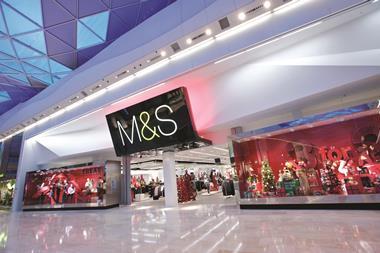High street retailers are slashing prices in the Christmas run-up, but is it the answer to their problems, asks Charlotte Hardie
It is not yet December but retailers are brandishing red pens like there is no tomorrow. You can barely see through shop windows for Sale signs plastered on glass.
Discount fever attracted particular attention last week when Retail Week revealed Marks & Spencer was to go head-to-head with a Debenhams three-day Sale Spectacular and run a 20 per cent discount day – its biggest pre-Christmas promotion for four years.
The media pounced. Headlines implied that M&S’s sales must have gone into meltdown and that the event was a desperate, panicked attempt to shift rapidly accumulating piles of stock. Regardless, it worked – so much so that executive chairman Sir Stuart Rose described consumer response as “a riot”.
M&S was not the only retailer to go down the discount event route. Dorothy Perkins ran a two-day Sale last week and House of Fraser – which, like Debenhams, is an old hand at running discount days – is offering 40 per cent off its own-brand merchandise and 25 per cent off branded goods as part of a two-day event.
All of this coincides with the barrage of e-mailed discount offers from retailers as diverse as Selfridges, Peacocks, Habitat, Threshers, Oasis, Karen Millen, Wallis, Gap and Bhs that are landing in the inboxes of “friends and family”. There are so many deals that consumers might struggle to pay full price for anything even if they tried.
The surge of shoppers to both M&S and Debenhams last week was proof that widely promoted discount days do boost footfall. But what is the significance of these promotions?
Ernst & Young retail team director Jason Gordon believes M&S’s action has been over-hyped by the media. “It’s been an overreaction. Times are tough and M&S is perfectly aware its customers are under pressure. This makes perfect sense and it is being responsive to what customers want,” he says.
Mosaic Fashions deputy chief executive Mike Shearwood agrees that people are reading too much into the level of discounting taking place on the high street. “People are overreacting to all this,” he says. “Everyone would obviously like to sell everything at full price, but if certain lines aren’t selling you still need to clear the stock and make space for new stock.”
He adds that a 20 per cent markdown is a worthwhile incentive for customers and one that will drive traffic online and into stores. Also, it will not have a disastrous effect on margin. “You make a pretty good margin even at 50 per cent. It’s only when you start to get to 70 per cent that it gets difficult,” he says.
While some interpret widespread discounting as a symptom of panic in retail boardrooms, many more believe it is a shrewd strategy – providing it has been factored into the bottom line.
Singer Capital Markets analyst Matthew McEachran says that from a City perspective, discounting comes as no surprise. “Some appear to be more of a direct response to terrible sales, but it’s a sensible approach,” he maintains. “The markdown problem will be far less severe than it would if they delayed discounting until the new year,” he says.
Unless some product is discounted now, retailers may not be able to shift it at all. By the time January comes, the party is over and the Christmas hangovers have set in. Who wants to buy a party dress in the new year Sales? Those businesses with a cleaner stock profile by the end of the Sale period in January will be in a far better position to begin trading in what will be a difficult year.
Big promotional events often require significant preparation too, so the view that they are a knee-jerk reaction to a sudden drop in weekly sales figures is often unjustified. M&S is certainly keen to rebut that view. A spokeswoman says: “We need to get the product into stores, everyone has to be notified, adverts have to be booked. If we hadn’t planned it, it wouldn’t have been a success.”
Discounts and friends and family offers are not a new phenomenon. All the retailers involved have run them before. What is more, they work. They not only drive footfall and sales, but generate PR. Mark Pearson, chief executive of the deal, discount and special offer web site Myvouchercodes.co.uk says: “They get a lot of coverage in the press and everyone wants a piece of the action. It gets your brand in front of people, gets people through the door and they’ll probably end up spending more than they would have done once they’re there.”
Risks and rewards
That said, there are potential – and major – pitfalls. One is the risk that customers will start to view 20 per cent discounts as a little paltry.
Viral marketing campaigns, for instance, started life in the US, where retailers always ensured they were tightly controlled. To begin with they really were only for friends and family, and even when expanded to the wider public retailers ensured discounts did not go beyond 20 per cent.
But there are signs that retailers are taking it several steps further. Gap’s e-mailed discount campaign offers 30 per cent off for friends and family, while Habitat is running a 30 per cent friends and family four-day offer from Thursday December 4 to Sunday December 9. Meanwhile, Threshers has revived its 40 per cent friends and family deal.
There are also signs they are running for longer. Peacocks is offering a nine-day 40 per cent-off event for friends and family, which ends on Sunday.
So where is the end of the road? Retailers run the risk of having to keep slashing prices as consumers come to expect bigger bargains. There is a need to shift stock, but if stores develop a price-cutting addiction, before they know it they will have driven top-line sales entirely at the expense of their margin.
John Lewis managing director Andy Street is sceptical about the value of early discounting. He argues: “Consumers are feeling bewildered and bombarded by messages about discounting. This can definitely drive sales on one day but is a short-term approach that can ultimately lead to mistrust in the brand as customers expect prices to be competitive at all times, not just sporadically.”
There is also a debate as to whether extensive Sale events do anything to foster customer loyalty in the long term. Pearson says more retailers need to ensure they are taking customer details and capturing data that can be used to help build customer relationships and keep them informed about future offers.
House of Fraser does just that. Brand director Matt Chambers says its main promotion has been that offered through its House of Fraser store card, which is 20 per cent off for card holders for six weeks until December 12. He says: “In our view it’s much more likely to drive loyalty and we will reap the benefits of that right through until spring.” But, he adds: “That doesn’t mean we haven’t done extremely well on special days, because we have.”
Discounts are only one way to lure shoppers in this difficult, competitive climate where everyone is fighting for every sale. The product range and customer service needs to be right, too. And that, says Shearwood, is one of the risks of in-store discount events.
“They drive sales hard for a limited period, so in a store that means you’re getting increased footfall but you’re also getting massive queues.” Customers have a different service, he says. “They end up buying a lot of product without trying it on, then decide they don’t like it or it doesn’t fit, and you have to fork out for refunds.”
Success depends on the level of planning. Just as retailers must anticipate and factor in surges in traffic both online and in stores, they need to prepare for the post-promotional dip. Critical in making these events a success is ensuring optimum staffing levels, maintaining a focus on customer service and making sure web sites can cope with increased online traffic. Debenhams’ web site went down temporarily last Friday for this very reason.
In such an environment retailers need to come up with something to tempt customers and price and promotions are an obvious way to do that. However, if the overall offer is not up to scratch, knocking 20 per cent off the asking price will be of little use.
There is also a danger that discount days and e-mailed offers end up becoming perpetual or too cyclical. Retailers need to avoid predictability. Gordon points to two US retailers, for instance, that stuck to rigid markdown plans based on discounting at 20 per cent for a set length of time, then 50 per cent and so on. “If something is that rules-based, customers are not stupid, they’ll wait for it. The key is mixing it up,” he says.
Despite the risks, retailers have very little choice at the moment other than to slash prices across the board. They are playing a logical game and taking no chances.
Nevertheless, it is widely expected to be one of the worst Christmases that most retail chief executives have experienced. This discounting frenzy is not the answer to their problems. As Gordon says: “The challenges facing the high street are so large it’s a bit like putting a Band-Aid over a huge wound.”


























No comments yet